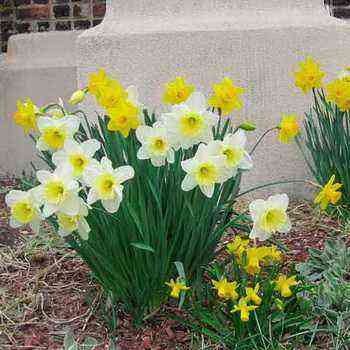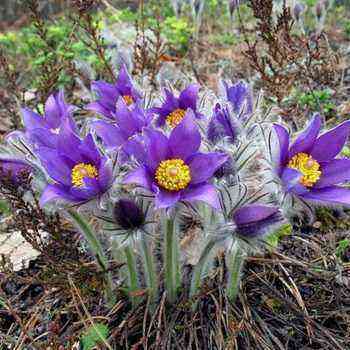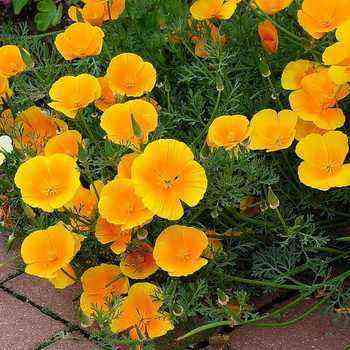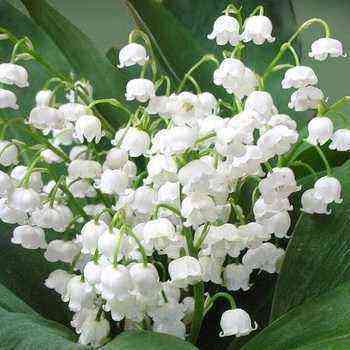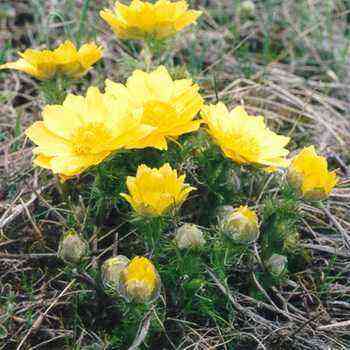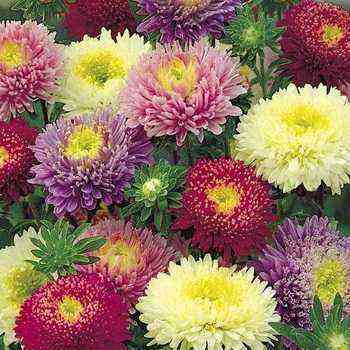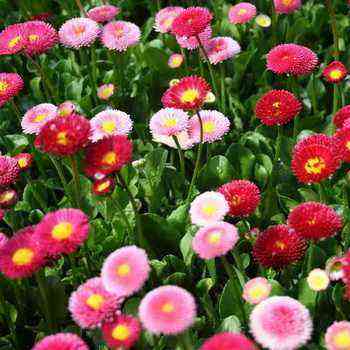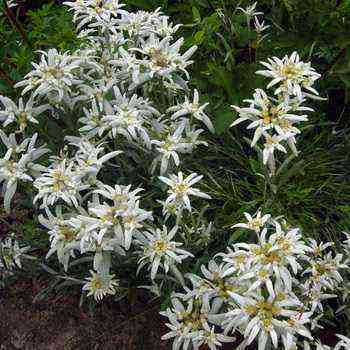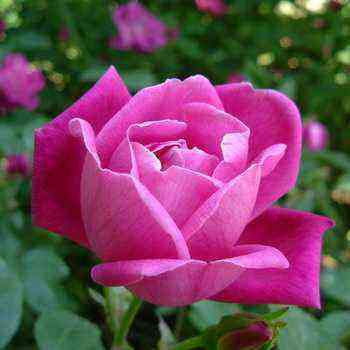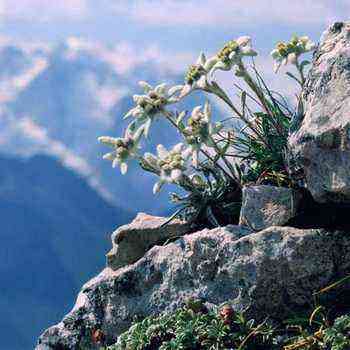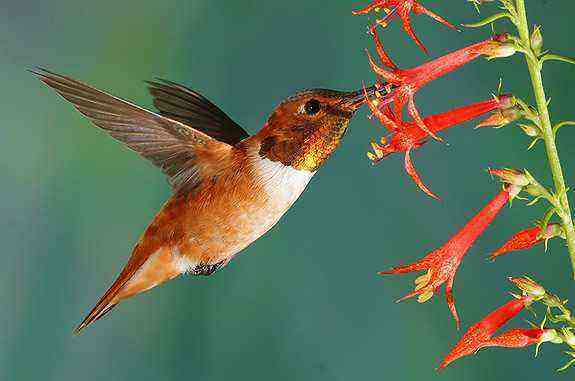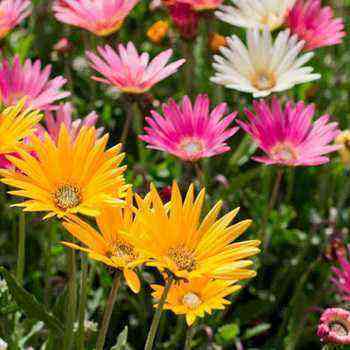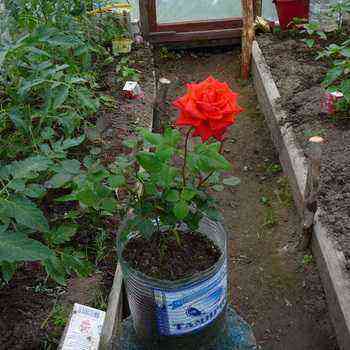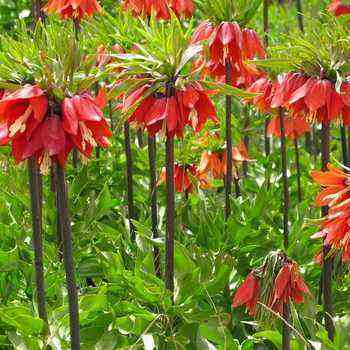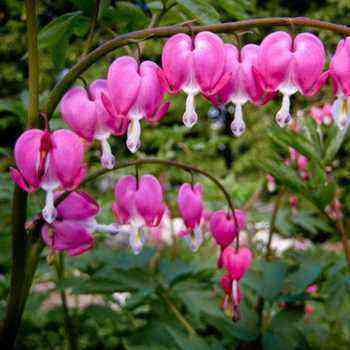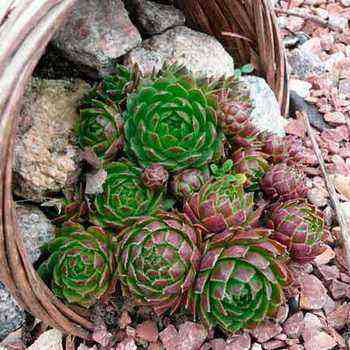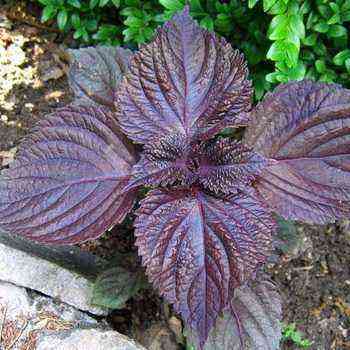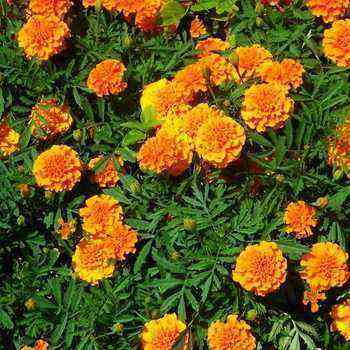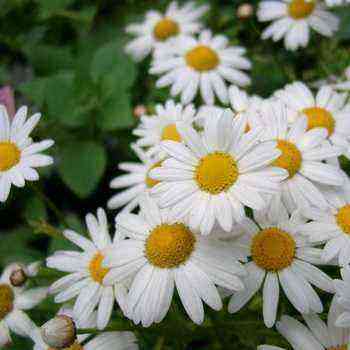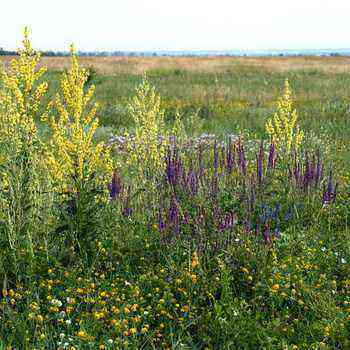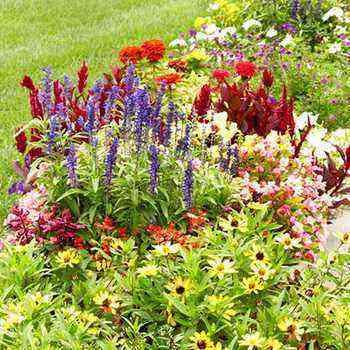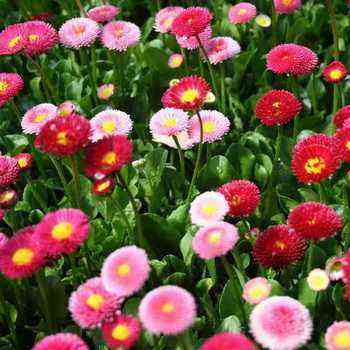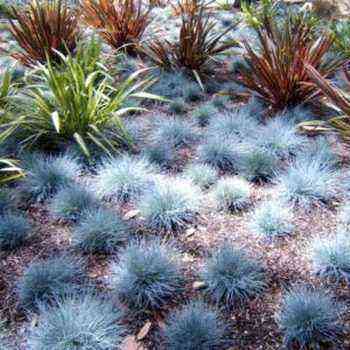 Corm perennials are very popular with gardeners. First, they don’t need to be planted every year. Secondly, all tuberous flowers are exceptionally decorative. True, caring for them is not as easy as for plants propagated by seeds or shoots, but it’s worth it!
Corm perennials are very popular with gardeners. First, they don’t need to be planted every year. Secondly, all tuberous flowers are exceptionally decorative. True, caring for them is not as easy as for plants propagated by seeds or shoots, but it’s worth it!
Photos and names of tuberous plants are offered to your attention on this page. You will also learn in what conditions you need to grow corm flowers and how to propagate them.
Tuberous perennials: corydalis, gladiolus, crocosmia
Corydalis (CORYDALIS). Dymyankov family.
Perennial tuberous corydalis are mainly low (10-30 cm) plants with a tuber, growing in temperate deciduous forests. The leaves are green, often bluish, appear in early spring and die off by the end of May, that is, these are typical ephemeroids. Flowers are collected in a raceme at the top of the stem, bloom in May, in June – bear fruit, form self-seeding.
Types and varieties:
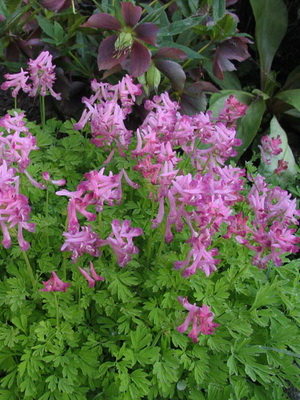

More often than other species, the corydalis (C. cava) is grown with delicate, repeatedly divided leaves and lilac flowers.
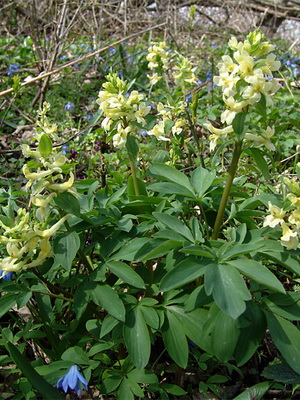
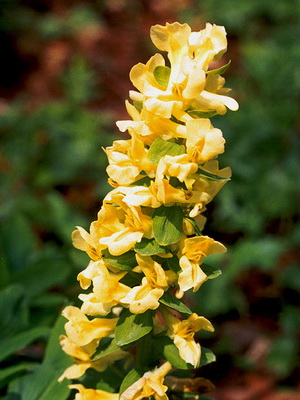
Marshall’s Corydalis (C. marchalliana) – mostly with creamy yellow flowers.
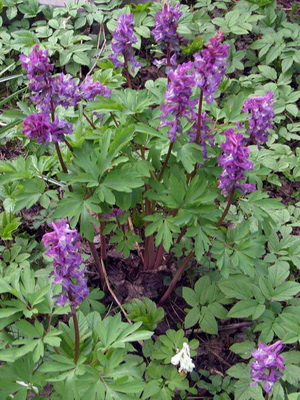
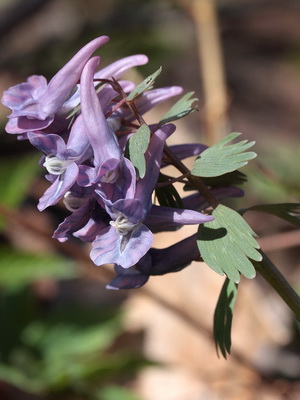
Haller’s Corydalis (C. halleri) – pinkish-purple flowers.
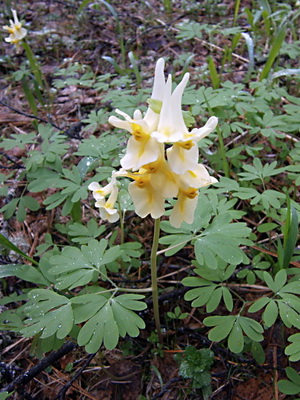

Corydalis (C. bracteata) – large light yellow flowers.
Growing conditions. Shady places with loose forest soils.
Breeding. Seeds (sowing freshly harvested) and tubers. Planting at the end of summer to a depth of 5-7 cm. Planting density – 25 pcs. per 1 m2.
Shady areas are suitable, among shade-loving forbs, in “natural garden” type plantings.
Gladiolus, skewer (GLADIOLUS). Iris family.
The name comes from the Latin gladus – “sword” and is given by the shape of the leaves of this plant. There are about 200 species in the genus, all of them tuber-bulbous.
The corm is flattened, lives one season. It is renewed due to tuber-onion-children.
Perennials with xiphoid leaves, erect stem, bearing an inflorescence-spike at the top with 10-30 funnel-shaped flowers.
Thousands of varieties of these tuberous plants are known, but they are divided into 5 groups:
- by the size of the flower (giant – the diameter of the flower is more than 14 cm, large-flowered – 11-13 cm, medium – 9-11 cm, small – 6-9 cm, miniature – less than 6 cm);
- by color, the varieties are divided into 13 classes (white, green, yellow, orange, salmon, salmon pink, red, raspberry, pink-lilac, purple, chestnut, smoky, brown);
- according to the flowering period , early (blooming from the end of July), medium (from mid-August), late (from the end of August) are distinguished. One peduncle blooms for about 10 days.
According to the arrangement of flowers in the inflorescence, groups are distinguished: single-row, double-row, alternate, double-sided, spiral.
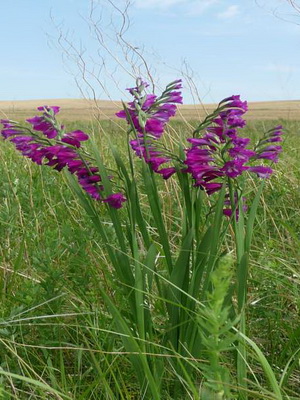

Pay attention to the photo of these tuberous flowers: gladioli, among other things, differ in the shape of the petals: they can be simple, corrugated, folded and dissected.
Types and varieties:
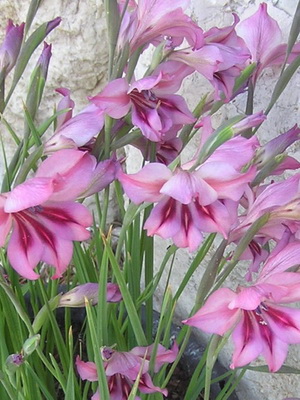

Gladiolus hybrid (G. xhybridus) , which is mainly grown by flower growers, is created as a result of complex hybridization with the participation of African species. Types of gladiolus of temperate flora are rarely used, since they have small, rapidly fading flowers.
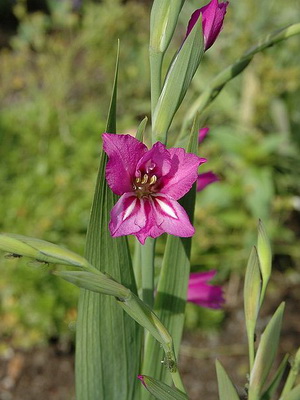

But species such as the tiled gladiolus (G. imbricatus) can be used in “natural garden” -type flower beds.
These tuberous garden flowers are best grown in separate flower beds. But lower grades can be used in mixborders.
Crocosmia, montbrecia (CROCOSMIA = MONTBRETIA). Iris family.
They are perennial tuberous flowers with narrow, xiphoid leaves and funnel-shaped orange-yellow flowers. Height 50-60 cm. In central Russia, mainly cultivars are grown. They have small (2 cm) corms, which form numerous underground stolons, and on them are young plants.
Known varieties:
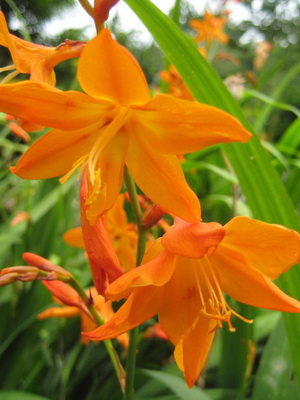
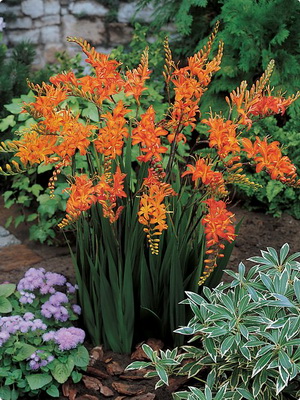
“Star of the East” – with pale orange flowers.

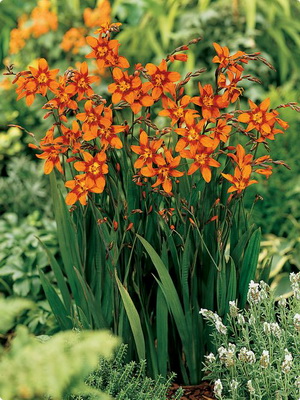
“Chees Madgest” – with orange-scarlet flowers.
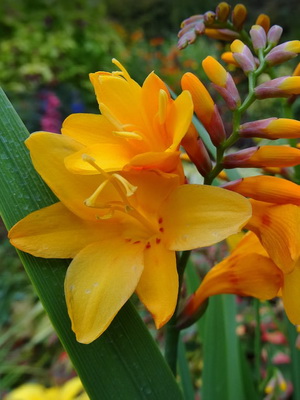
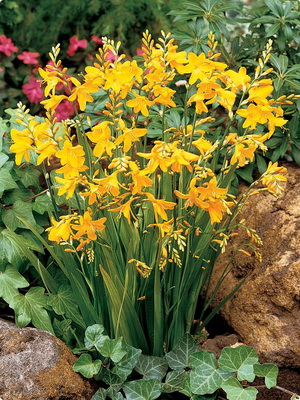
“CitroneLLa” – lemon-yellow flowers.
Growing conditions. Protected from the wind, sunny areas with loose, rich, well-drained soils. For the winter, it is necessary to cover with spruce branches or fallen leaves of oak, maple, it is possible to use a thin non-woven covering material.
Breeding. Seeds, children – in the spring. Seedlings bloom in the 3rd year. Planting density – 16 pcs. per 1 m2.
Corm flowers: crocus, crocus, liatris
Below are photos and names of tuberous flowers of the Iris, Astrov and Kolkhikumov families.
Crocus, saffron (CROCUS). Iris family.
Small (10-15 cm) corms with a goblet flower and narrow leaves with a white stripe, collected in a bunch. About 90 species are known to grow in the mountains of Southern Europe and the Caucasus.
Species and varieties. Spring blooming (bloom in April):
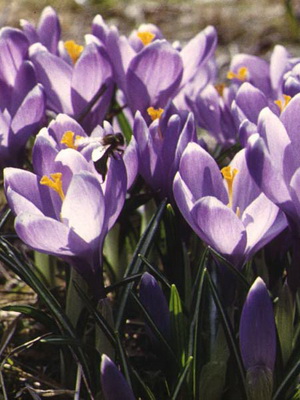
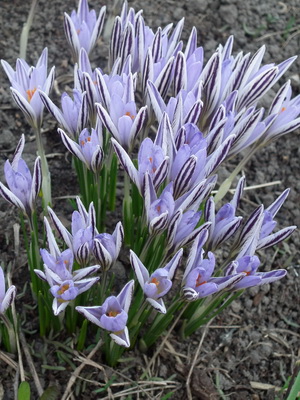
Spring crocus (C. vernus) and its varieties:
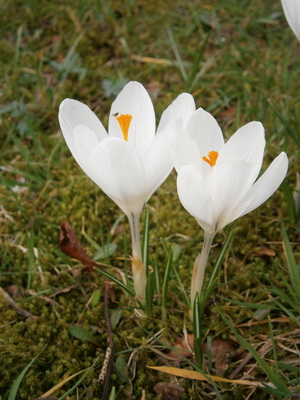
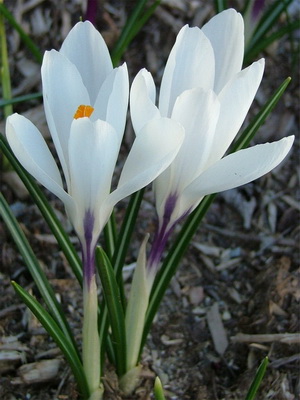
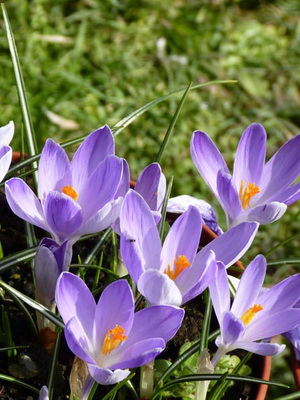

“Jeanne D” Arc, “Vanquard” , the earliest “Nigro”, etc.

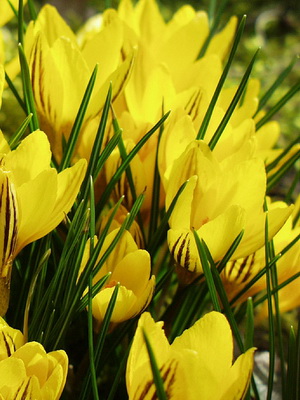
Golden-flowered crocus (C. chrysanthus) , cultivar “Saturnus”.
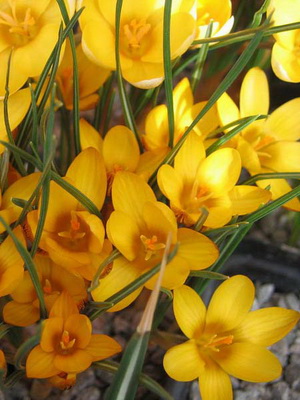
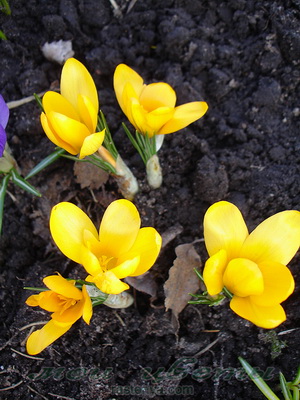
Light yellow crocus (C. flavus) , cultivar “Largest YeLLow”.
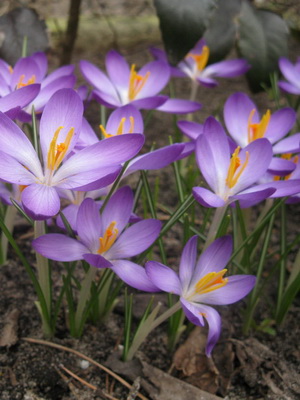
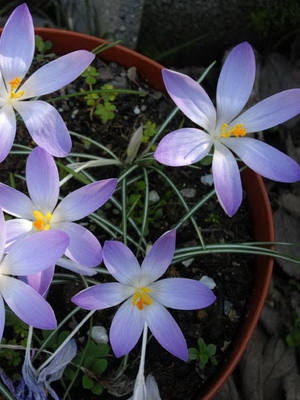
Crocus Tomasini (C. tomasinianus) , cultivar “LiLac Beauty”, etc.
Autumn blooming (bloom in September):
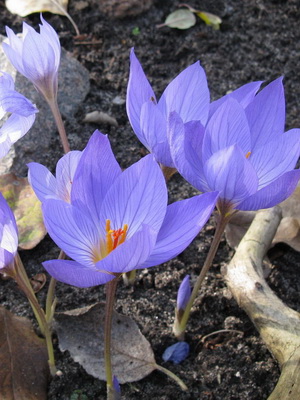
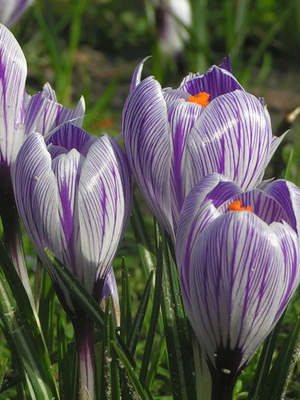
Crocus is beautiful (C. speciosus) , K. pallas (C. pallasii).


Hill crocus (C. vallicola).
Growing conditions. Sunny plots with sandy or stony soils, you can also use ordinary garden plots, but without organic fertilizers.
Breeding. Corms – babies after the end of flowering. Dig up every 4-5 years for rejuvenation. Planting density – 36-40 pcs. per 1 m2.
Use in rockeries, mixed flower beds, gravel gardens. Interesting for forcing. Crocus varieties fade very quickly (after 5-6 days), therefore, to prolong the flowering effect, different varieties are combined in one group.
Colchicum, colchicum (COLCHICUM). Colchicum family (liliaceae).
About 70 species of this genus grow in the damp meadows of the Mediterranean, the Carpathians, and the Caucasus. They have an oblong corm, large, elongated lanceolate leaves are formed in the spring, by the beginning of summer they die off. At the end of summer, a lilac-purple flower (height 15 cm) appears with accrete petals, narrowed at the bottom into a long tube, and at the top – funnel-shaped.
Species and varieties. About 20 species are grown in culture, more often than others autumn-flowering:

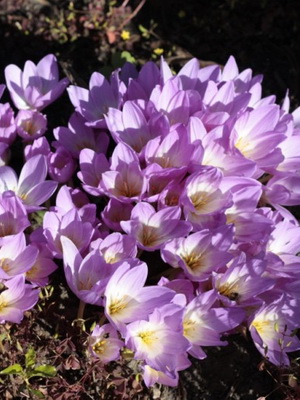
Colchicum magnificent (C. speciosum) and autumn (C. autumnale) .
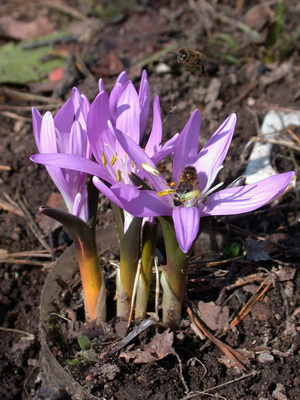
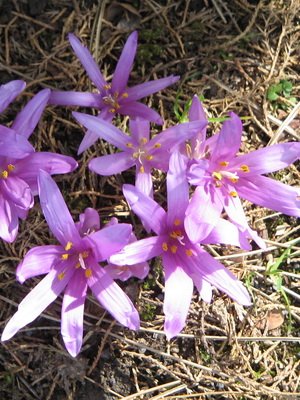
And also the spring-blooming autumn crocus (C. bulbocodium = Bulbocodium vernum) . There are numerous varieties of autumn-flowering colchicum.
Growing conditions. Sunny areas with rich, moist, alkaline soils.
Breeding. Bulbs – children (in August), seeds (seedlings bloom in the 5-6th year). Planting density -12 pcs. per 1 m2.
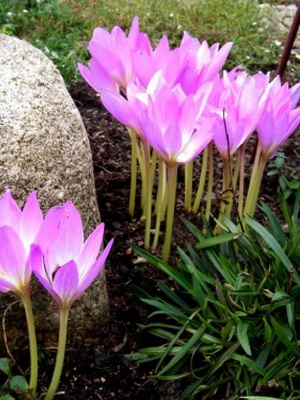
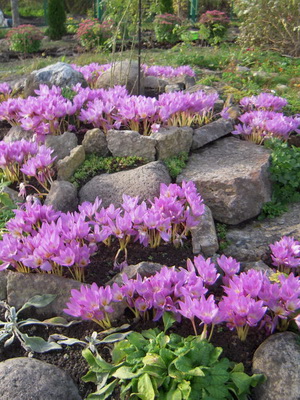
As you can see in the photo, these tuberous plants are used in mixed flower beds, in the foreground of mixborders, near the water. Forcing is possible.
Liatris (LIATRIS). Aster family (Compositae).
Rhizome perennial from dry meadows of North America. Stems do not branch, erect, 50-80 cm high, leafy.
Types and varieties:
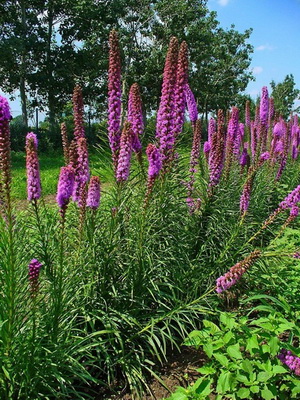
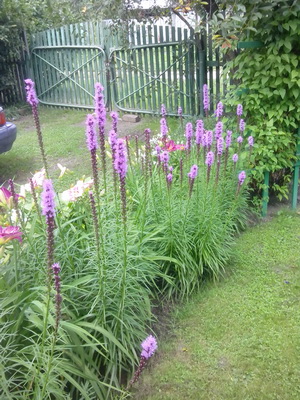
Leatris Spikelet (L. spicata) , varieties:
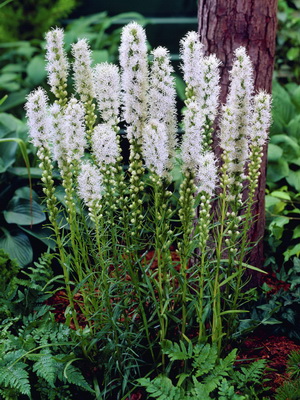

Alba “,” Kobold “ – wet soils.
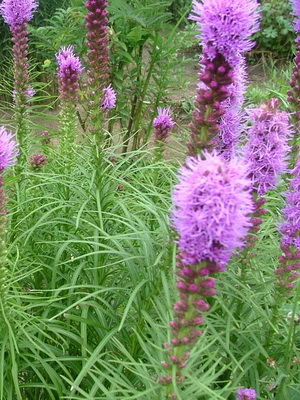

Filmy liatris (L. scariosa) – dry soils.
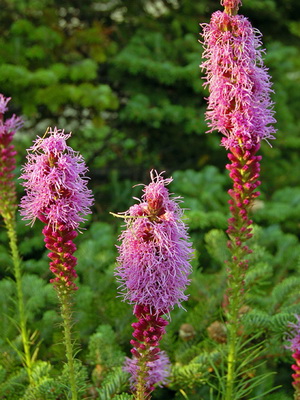
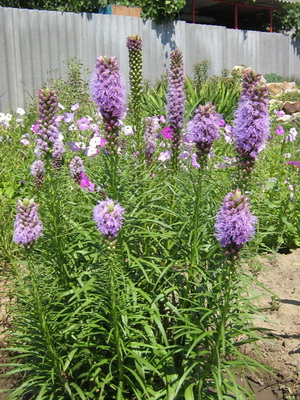
Liatris thick-headed (L. pycnostachya) – dry soils.
Growing conditions . Sunny (or on the east side of the house) areas with rich, loose, moderately moist soils.
Breeding. Seeds (sowing in spring), seedlings bloom in the 2nd year. By dividing the bush (in spring). Tuberous rhizomes grow rapidly, so the bush is divided every 3-4 years. Planting density – 12 pcs. per 1 m2.
Perennial tuberous plants: arum, cottonwood, trillium
Aronnik (ARUM). Aroid family.
Original perennials with tuberous rhizome. These are mainly plants of the Mediterranean, where they live in dry sparse forests. The leaves grow in early spring, they are arrow-shaped; in mid-May, small, expressionless flowers appear, collected in an inflorescence-ear, covered with an oval blanket. Bedspreads are white with a dark edge or dark red. Bright red berries adorn plantings in August.
Types and varieties:
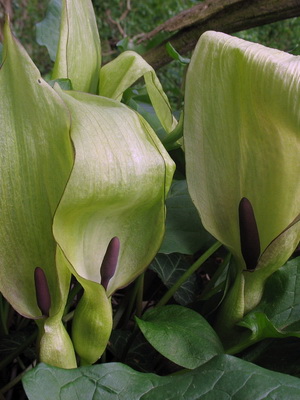
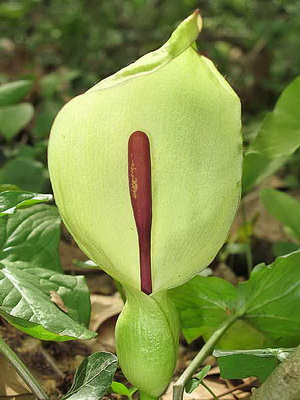
Spotted Aronica (A. maculatum) – white veil.
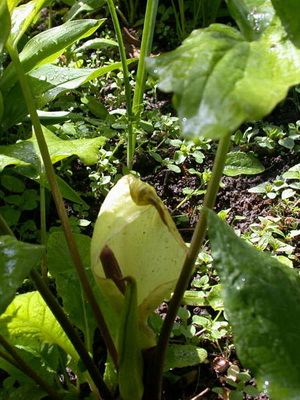

Eastern aronnik (A. orientale) – greenish-white bedspread with interception.
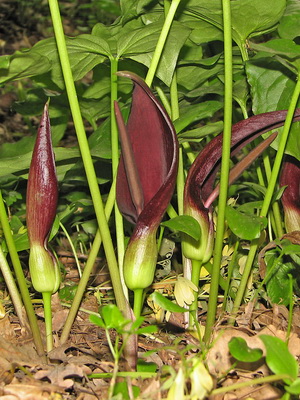
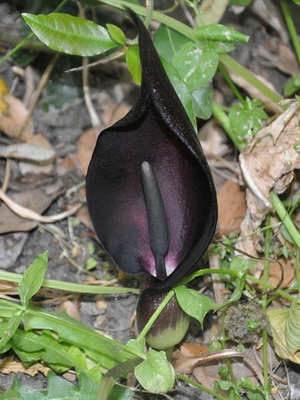
Aronnik elongated (A. elongatum) – with a velvety dark red veil.

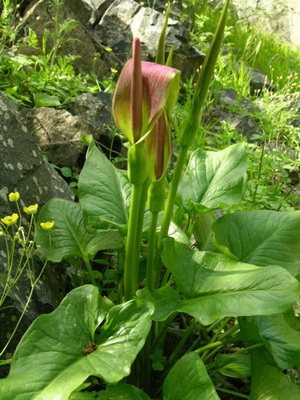
Aronik Korolkov (A. korolkovii) – elongated, greenish veil, above the leaves.
Growing conditions. Shaded areas with well-drained, neutral, rich forest soils without stagnant moisture, under the canopy of trees, which provides shelter for the winter with leaf litter. Collecting litter is not recommended. A perennial does not need frequent transplants.
Breeding. Seeds (sowing only freshly harvested) and areas of rhizomes with a bud of renewal (in summer, after the leaves have dried out). Shallow landing (3-5 cm). Self-seeding is formed under suitable conditions. Planting density – 3-5 pcs. per 1 m2.
Cotton wool (ASCLEPIAS). Gusset family.
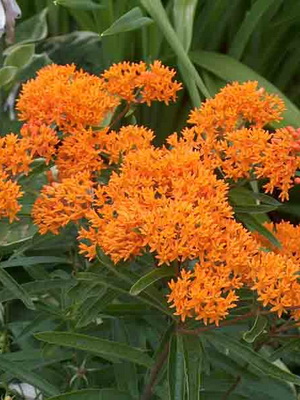

Tuberous wool (A. tuberosa) is a plant of the steppes. Medium-sized (50-80 cm) bush of strong unbranched shoots, covered with oval hairy leaves. Small orange-yellow flowers in paniculate inflorescence.
Growing conditions. Sunny areas with garden soils and normal moisture. Cover with spruce branches for the winter.
Breeding. Seeds (sowing before winter) and dividing the bush (in spring and late summer). Planting density -5 pcs. per 1 m2.
Trillium (TRILLIUM). Family of triallium (liliaceae).
These corms are found naturally in the forests of East Asia and North America. They have long been known in culture, but due to the difficulties of reproduction in gardens, they are still rare. However, the attractiveness and longevity of trilliums make flower growers spare no effort in growing them. Trilliums have a vertical tuberous rhizome, from which a stem 20-40 cm high with a whorl of three leaves and a single flower above them departs. Trillium has only three – three leaves, three petals, three sepals.
Species and varieties. Most often cultivated:
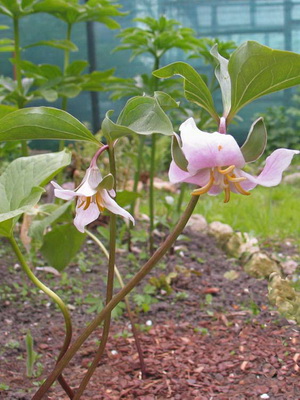
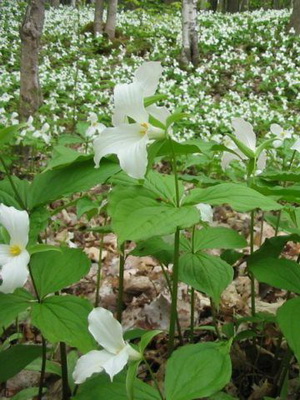
Trillium of Gleason (T. gleasonii) and Kamchatka (T. camtschatcense).

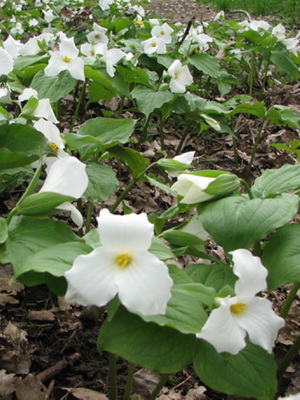
Trillium large-flowered (T. grandiflorum) and erect (T. erectum).

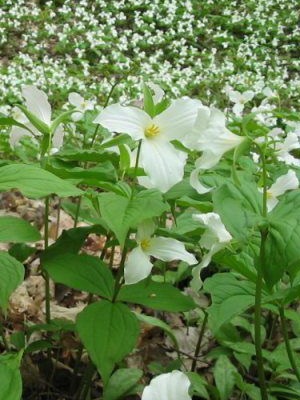
Snow trillium (T. nivale) – all of them with white flowers.
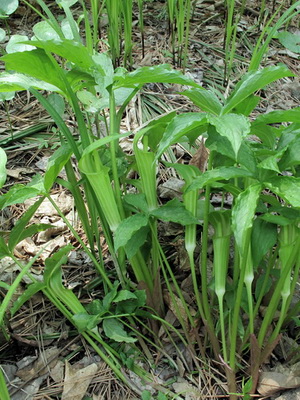
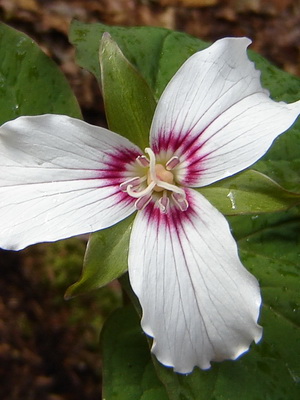
At Trillium corrugated (T. undulatum) – flower white with pink center.
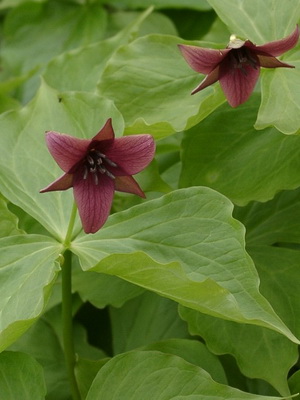
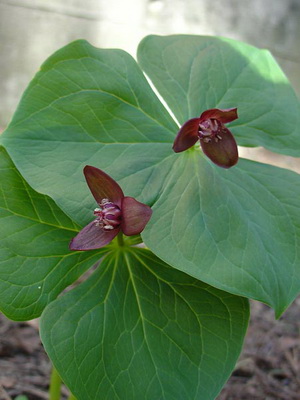
Red-brown flowers are characteristic of green trillium (T. viride) , trillium Small (T. smallii).
Growing conditions. Trilliums are shade-loving plants that grow well only on loose fertile forest soils with moderate moisture and shelter for the winter with litter from leaves of broad-leaved species.
Breeding. Trilliums are difficult to reproduce as they grow very slowly. The division of the bush is carried out at the end of summer. Seeds sown before winter germinate only in the 3rd year, and the seedlings that appear bloom in the 4th-5th year. Stocking density – single.
Bulbous perennials: arizema, symlocarpus, tigridia
Arisema (ARISAEMA). Aroid family.
Graceful, spectacular exotic plants, mainly found in tropical forests. But several species from the forests of the Far East and North America grow well in central Russia, where they even form self-seeding. These are perennials with a tuberous rounded rhizome, from which a stem grows with dark green leaves and an inflorescence-cob. The ear is covered with a curved bedspread with stripes. In late summer, the plants are adorned with bright red berries.
Types and varieties:
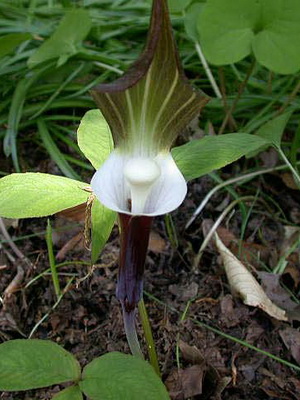
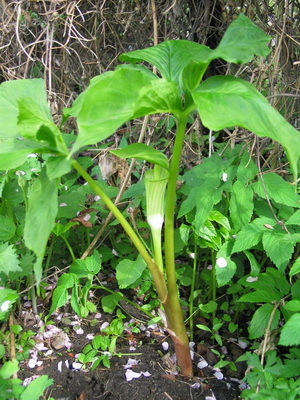
Amur arizema (A. amurense) and powerful (A. robustum) are distinguished by a greenish goblet blanket located under the leaves.
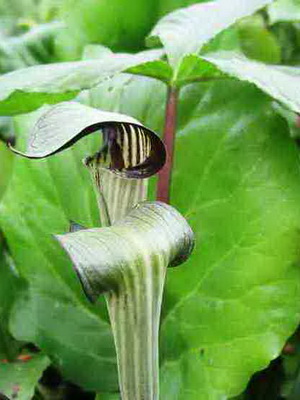
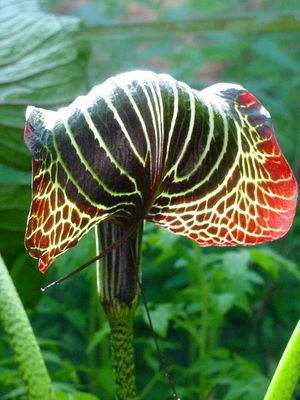
Arizema japonica (A. japonicum) is a magnificent plant in which a tall, dark-spotted (like the skin of snakes) peduncle bears an inflorescence above the leaves.

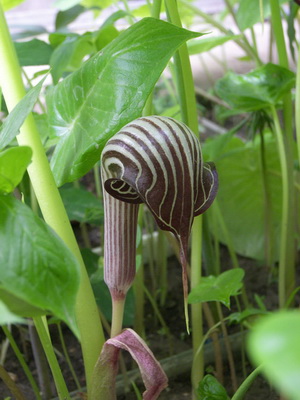
In arisaema trifoliate (A. triphyllum) covered red with white stripes.
Growing conditions. Shaded areas with fertile peaty, highly moist soils under the canopy of trees. Be sure to cover with leaf litter for the winter.
Landing only in single copies.
Breeding. Seeds (sowing freshly harvested in August-September), self-seeding often appears. Seedlings bloom in the 2-3rd year. It multiplies well at the end of summer by patches of tuberous rhizome with renewal bud.
The best decoration for shaded flower beds. Stably decorative all season. It is interesting against the background of evergreen low-growing moisture-loving ground cover: tiarkas, lambs, near water and in shady rockeries.
Symplocarpus (SYMPLOCARPUS). Aroid family.

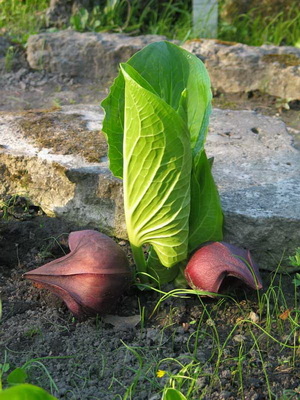
Simplocarpus stinks (S. foetidus) is a magnificent exotic from the shady forests of the Far East and East of North America. A relic of ancient times, it grows well in central Russia (in suitable environmental conditions) and even forms massive self-seeding. The rhizome is thick, tuberous. It blooms immediately after the snow melts, the bedspread is dark red, velvety, in the form of a beak; leaves grow back after the end of flowering, they are large (up to 100 cm), in a basal rosette. At the end of August, beautiful fruits ripen – red berries.
Growing conditions. Shady areas with peaty wet soils.
Breeding. Seeds (freshly harvested) in September. Dividing and transplanting in an adult state does not tolerate well. Stocking density – singly.
Tigridia (TIGRIDIA). Iris family.
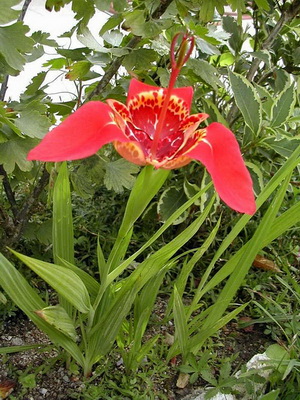

Peacock tigridia (T. pavonia) is a bulbous plant from Mexico. The corm is elongated, covered with a dark brown film. The leaves are xiphoid, folded lengthwise.
The flower is exotic beautiful, up to 12 cm in diameter, cupped, located on a high peduncle (50–70 cm). It is cultivated as a gladiolus, that is, it is planted in the spring (after the end of frost), dug up in the fall, stored in dry sand at a temperature of 5-10C °.
There are varieties:
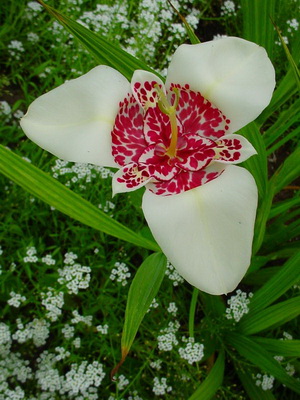

“Alba” – with white flowers with red spots.
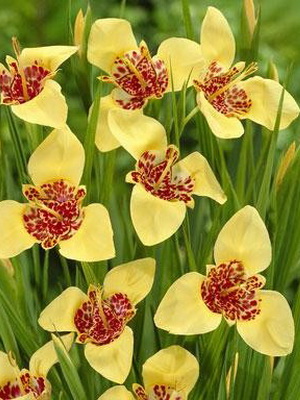
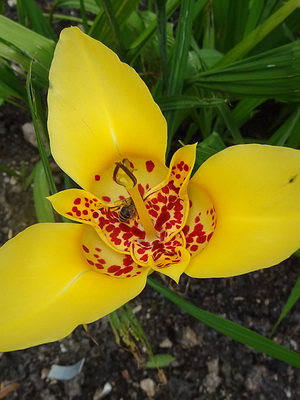
“Aurea” – dark yellow flowers with carmine spots.


“Carminea” – orange with yellow spots.

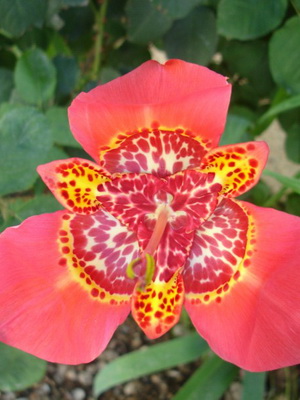
“Lilacea” – purple-red with dark spots.
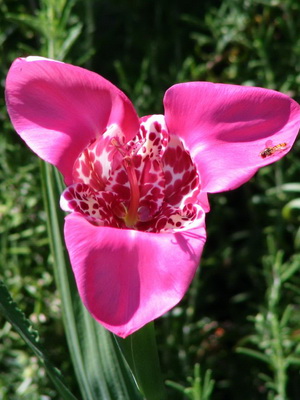
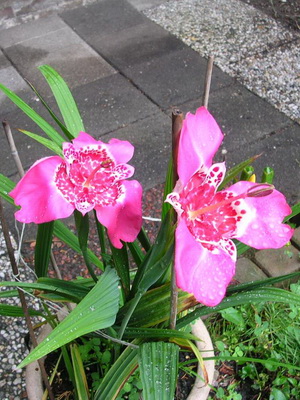
Rosalind is pale pink.
Growing conditions. These tuberous perennials prefer sheltered, sunny locations with fertile light, loose soils.
Breeding. Corms. It is possible to grow from seeds (but not varieties), seedlings bloom in the 1-2 year. Planting density – 16 pcs. per 1 m2.


